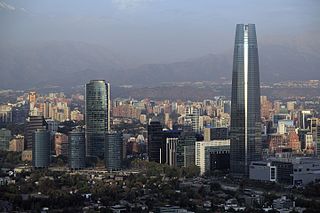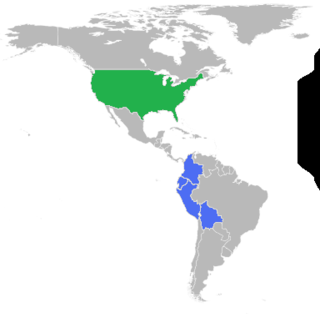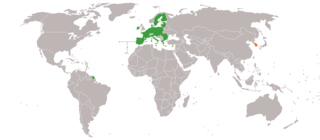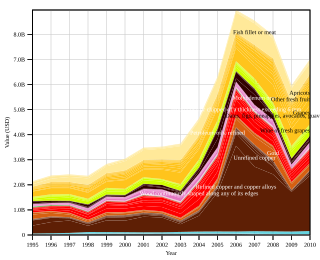
The economy of Chile is a market economy and high-income economy as ranked by the World Bank. The country is considered one of South America's most prosperous nations, leading the region in competitiveness, income per capita, globalization, economic freedom, and low perception of corruption. Although Chile has high economic inequality, as measured by the Gini index, it is close to the regional mean.

The Tariff Act of 1930, commonly known as the Smoot-Hawley Tariff or Hawley-Smoot Tariff, was a law that implemented protectionist trade policies in the United States. Sponsored by Senator Reed Smoot and Representative Willis C. Hawley, it was signed by President Herbert Hoover on June 17, 1930. The act raised US tariffs on over 20,000 imported goods.

The Dominican Republic–Central America–United States Free Trade Agreement is a free trade agreement. Originally, the agreement encompassed the United States and the Central American countries of Costa Rica, El Salvador, Guatemala, Honduras, and Nicaragua, and was called CAFTA. In 2004, the Dominican Republic joined the negotiations, and the agreement was renamed CAFTA-DR.
The Australia – United States Free Trade Agreement (AUSFTA) is a preferential trade agreement between Australia and the United States modelled on the North American Free Trade Agreement (NAFTA). The AUSFTA was signed on 18 May 2004 and came into effect on 1 January 2005.
The US-Morocco Free Trade Agreement is a bilateral trade agreement between the United States and Morocco. The agreement was signed on June 15, 2004, followed by U.S. President George W. Bush's signing of the USMFTA Implementation Act on August 17, 2004. The United States House of Representatives ratified the pact on July 22, 2004 by a 323–99 vote. The United States Senate passed the bill by unanimous consent on July 21, 2004. The Morocco FTA came into effect on January 1, 2006.
The United States–Peru Trade Promotion Agreement is a bilateral free trade agreement, whose objectives are eliminating obstacles to trade, consolidating access to goods and services and fostering private investment in and between the United States and Peru. Besides commercial issues, it incorporates economic, institutional, intellectual property, labor and environmental policies, among others. The agreement was signed on April 12, 2006; ratified by the Peruvian Congress on June 28, 2006; by the U.S. House of Representatives on November 2, 2007, and by the U.S. Senate on December 4, 2007. The Agreement was implemented on February 1, 2009.
The United States–Jordan Free Trade Agreement is the first free trade agreement (FTA) between the United States and an Arab country. It is Jordan's second free trade agreement, after the 1997 Greater Arab Free Trade Agreement. The agreement, which grants duty-free status to nearly all Jordanian exports to the United States, was signed on 24 October 2000 and went into force on 17 December 2001. Rules of origin require that goods be composed of a minimum of 35 percent Jordanian content to be eligible for duty-free entry.
The United States–Israel States Free Trade Agreement (FTA) is a trade pact between the State of Israel and the United States of America established in 1985 to lower trade barriers in some goods. The agreement reduces rates of duty, and in some case eliminates all duties, on merchandise exported from Israel to the United States. The agreement also covers merchandise exported from the Gaza Strip and the West Bank.

The United States–Korea Free Trade Agreement, also known as KORUS FTA, is a trade agreement between the United States and South Korea. Negotiations were announced on February 2, 2006, and concluded on April 1, 2007. The treaty was first signed on June 30, 2007, with a renegotiated version signed in early December 2010.

The Andean Trade Promotion and Drug Eradication Act (ATPDEA) is a trade preference system by which the United States grants duty-free access to a wide range of exports from four Andean countries: Bolivia, Colombia, Ecuador and Peru. It was enacted on October 31, 2002 as a replacement for the similar Andean Trade Preference Act (ATPA). The purpose of this preference system is to foster economic development in the Andean countries to provide alternatives to coca production. Bolivia has installed capacity to industrialize coca production and its derivatives, since coca has no narcotic effects, but the United States does not make any difference between coca and cocaine. Thus, the U.S. government eliminated this "preference".
Qualifying industrial zones (QIZs) are industrial parks that house manufacturing operations in Jordan and Egypt. The QIZ program was introduced in 1996 by the U.S. Congress to stimulate regional economic cooperation. Goods produced in QIZ-designated areas in Egypt, Jordan and the Palestinian territories can directly access U.S. markets without tariff or quota restrictions, subject to certain conditions. To qualify, goods produced in these zones must contain a small portion of Israeli input. In addition, a minimum 35% value to the goods must be added to the finished product. The idea was first proposed by Jordanian businessman Omar Salah in 1994.

The European Union–South Korea Free Trade Agreement is a free trade agreement between the European Union (EU) and South Korea. The agreement was signed on 15 October 2009. The agreement was provisionally applied from 1 July 2011, and entered into force from 13 December 2015, after having been ratified by all signatories.
The ASEAN–India Free Trade Area (AIFTA) is a free trade area among the ten member states of the Association of Southeast Asian Nations (ASEAN) and the Republic of India. The initial framework agreement was signed on 8 October 2003 in Bali, Indonesia. and the final agreement was on 13 August 2009. The free trade area came into effect on 1 January 2010. India hosted the latest ASEAN-India Commemorative Summit in New Delhi on 26 January 2018. In the financial year 2017–18, Indo-ASEAN bilateral trade grew by almost 14% to reach US$81.3 billion. India's imports from ASEAN were valued at US$47.13 billion while its exports to ASEAN stood at US$34.2 billion.

The United States-Chile Free Trade Agreement is a free trade agreement (FTA) between the United States and Chile signed on June 6, 2003. The pact came into force on January 1, 2004. On that date, tariffs on 90% of U.S. exports to Chile and 95% of Chilean exports to the United States were eliminated. The agreement also established that Chile and the U.S. will establish duty-free trade in all products within a maximum of 12 years (2016). In 2009, bilateral trade between the United States and Chile reached US$15.4 billion, a 141% increase over bilateral trade levels before the U.S.-Chile FTA took effect. In particular, U.S. exports to Chile in 2009 showed a 248% increase over pre-FTA levels.

The China–Pakistan Free Trade Agreement(CPFTA) is a free trade agreement (FTA) between the People's Republic of China and the Islamic Republic of Pakistan that seeks to increase trade and strengthen the partnership between the two countries.
The China–South Korea Free Trade Agreement is a free trade agreement between China and South Korea signed in 2014 and active since the following year.
This article is intended to give an overview of the trade policy of South Korea. In 1945 Korea was liberated from the Empire of Japan at the end of World War II. A destructive drought in 1958 forced Korea to import large amounts of food grains. In 1950, the Korean war broke out, which destroyed more than two-thirds of the nation's production facilities and most of its infrastructure. Trade policy of South Korea has taken many shifts, from import substitution to globalization and there has been significant impact on the economy for the same.

The Canada–Korea Free Trade Agreement is a free trade agreement between Canada and South Korea. The agreement was concluded at the Blue House in Seoul on 11 March 2014 by Stephen Harper, the Prime Minister of Canada, and Park Geun-hye, the President of South Korea. It is the first free trade agreement between Canada and an Asia Pacific nation. The agreement entered into force on 1 January 2015.
The Canada–Peru Free Trade Agreement (CPFTA) is a free trade agreement between Peru and Canada. It was signed on 29 May 2008 and entered into force on 1 August 2009.

The Pork war was a ban by Germany and nine other European nations on U.S. pork imports in the 1880s. Due to repeated years of low crop yield, American pork and wheat became increasingly prevalent in these countries. This angered local farmers, who soon called for boycotts. They also cited vague reports of trichinosis that supposedly originated from American pork. Fueled by the growing policy of protectionism in Europe, many countries proceeded to ban all or some American pork, beef, and wheat imports. However, in 1891, after almost 20 years of economic tension, US President Benjamin Harrison threatened an embargo of Germany's sugar beets, forcing Germany to allow U.S. pork imports. Other nations quickly followed suit, fearing similar repercussions.











